Taking The Stand
 I just purchased the DVDs for the 2020 remake of Stephen King’s The Stand. And of course, binge-watched it. The Stand is one of my favorite all-time books and the 1994 series, one of my favorites. That said: Everything here is MY OPINION. Other’s may feel differently, and if they pay for web hosting, build a site, and write reviews, I will read their opinions. (Eh, probably not.) The remake has been out for a few years, but even so: MAJOR SPOILER ALERTS!
I just purchased the DVDs for the 2020 remake of Stephen King’s The Stand. And of course, binge-watched it. The Stand is one of my favorite all-time books and the 1994 series, one of my favorites. That said: Everything here is MY OPINION. Other’s may feel differently, and if they pay for web hosting, build a site, and write reviews, I will read their opinions. (Eh, probably not.) The remake has been out for a few years, but even so: MAJOR SPOILER ALERTS!
I’m going to break this down into several parts:
- Scripting/Changes,
- Casting/Performances, and
- General.
CH-CH-CHANGES
MAKE IT UNDERSTANDABLE
The story through the constant flashbacks in the Remake was both annoying and confusing. The chronologically linear story telling in The Stand: The Original Series (TS:TOS in places from here on out) was both more easily understood and a better story telling method. And that is what movies and books are supposed to do. Tell a good story. The Remake almost seemed to take it for granted that you had either read the book or seen TS:TOS. Had you not already known the plot and characters, it would have come across as a jumbled mess. Flashbacks are okay in small doses, but don’t overuse them.
SUMMARY: Too many flashbacks in the Remake. The linear story telling of The Stand : The Original Series was far superior.
SANING UP STARKEY
 In TS:TOS, General William Starkey was portrayed by Ed Harris. In the Remake, J.K.Simmons (an all time favorite of mine) played Starkey. The difference was in the scripting, not the performance. In TS:TOS, Starkey was written as semi-insane, possibly due to his part in the Captain Trips virus development and accidental release. He did have a ‘denial press conference’ that implied the military’s part in the virus. Harris played the general through the first episode of the original series and we would witness his steady decline into further insanity. It added to the tension/drama (see notes about Good Storytelling.)
In TS:TOS, General William Starkey was portrayed by Ed Harris. In the Remake, J.K.Simmons (an all time favorite of mine) played Starkey. The difference was in the scripting, not the performance. In TS:TOS, Starkey was written as semi-insane, possibly due to his part in the Captain Trips virus development and accidental release. He did have a ‘denial press conference’ that implied the military’s part in the virus. Harris played the general through the first episode of the original series and we would witness his steady decline into further insanity. It added to the tension/drama (see notes about Good Storytelling.) He wasn’t a Bad Guy, he was just a man whose actions or knowledge drove him over the edge. No offense to Mr. Simmons, but the cool, rational portrayal of him pulling out a service pistol and offing himself in one scene, just didn’t have the same emotional impact as Harris’ slow decline into insanity with the same result. Again, blame the script.
He wasn’t a Bad Guy, he was just a man whose actions or knowledge drove him over the edge. No offense to Mr. Simmons, but the cool, rational portrayal of him pulling out a service pistol and offing himself in one scene, just didn’t have the same emotional impact as Harris’ slow decline into insanity with the same result. Again, blame the script.
SUMMARY: In the Remake, Gen. Starkey calmly shoots himself in his one scene to avoid the painful death of Captain Trips – not due to any guilt on his part. In TS:TOS, Gen. Starkey slowly declines into insanity and kills himself out of guilt, not cowardly avoiding a painful death. TS:TOS was much more dramatic and not-so-subtly implied this was all mankind/the military’s fault. Harris’ Starkey was much more nuanced in his characterization.
WHEN IN DOUBT, GROSS IT OUT
One change in the Remake vs. TS:TOS is the level of grossness, especially in the depiction of the Captain Trip’s victims. This was likely on purpose, but I am a believer that sometimes, grossness (and gratuitous violence) is sometimes more effective as a story telling tool when not seen directly. Mucus-dripping, sweat covered faces covered in sores made me comfortable with the fast forward button.
One improvement in the Remake was showing Campion’s part in the Lockdown and (supposedly) Flagg’s boot blocking the door, allowing Campion to leave and spread the disease. That ratcheted up the Evil Meter on Flagg a few notches. In The Stand : The Original Series, it was all portrayed as a bad accident with the omni-present crows around. The Remake made Flagg more sinister and all of the death was not an accident.
CHAMPION CAMPION
The casting of Campion (Curtis Cook Jr.) was another change that worked as well as how they changed his part. Instead of just an AWOL gate guard, they had Campion be the one who executed the lockdown, and then escaped with his family. The casting change may have been inspired by political correctness, but it still worked.
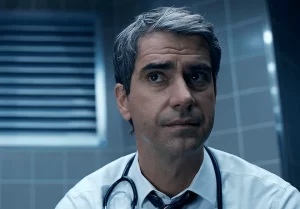 DR. ELLIS
DR. ELLIS
Another positive change was the addition of Hamish Linklater as Dr. Jim Ellis, the virologist who befriends Glen and plays straight with him. It’s nice to see a human being in the military/industrial complex honestly fighting the virus. It was a pleasant twist in the whole evil military/mad scientists = bad trope. His motivations were very human. He wanted a Nobel Prize for beating Captain Trips. This was an addition to TS:TOS and book that added some depth to the characterizations.
NADINE VS. RITA
 In TS:TOS, Larry Underwood meets Nadine in New York and after a brief, but tempestuous affair (she’s bat-shit crazy and addicted to drugs), go their separate ways. He then meets Lucy and young Joe in Kansas on his way west. His relationship with Lucy is yet another drama/flash point for jealousy for Nadine when they reunite in Boulder. This extra bit of friction helps make the Nadine “craziness-arc” a little more organic. In the Remake, Larry meets Rita in NY and she kills herself shortly after by overdosing. End of conflict/drama. Less interesting a story. In TS:TOS, Nadine has a panic attack and shows/goes a little more crazy when she has to traverse one of the darkened tunnels out of town filled with dead bodies. The Remake tried to do that a bit with Rita and the sewers, but it was a little anemic plot thread that didn’t go anywhere. Less traumatic = less impactful. She ended up semi-rescuing Larry, which “Yay! Empowered women. Boo! Weak plot development.” Repeat: It is supposed to be about Good Story Telling. Not political correctness. (According to ScreenRant.com https://bit.ly/3tARUmH, King himself wrote her out of the original screenplay for timing and her “shocking end that started Larry on the path to redemption for his former selfish, devil may care rock star lifestyle, and led to his worthiness to stand against Flagg..” Meh. Rita, while in the original book, was a just a dead end plot thread in a story full of heavy character interactions.
In TS:TOS, Larry Underwood meets Nadine in New York and after a brief, but tempestuous affair (she’s bat-shit crazy and addicted to drugs), go their separate ways. He then meets Lucy and young Joe in Kansas on his way west. His relationship with Lucy is yet another drama/flash point for jealousy for Nadine when they reunite in Boulder. This extra bit of friction helps make the Nadine “craziness-arc” a little more organic. In the Remake, Larry meets Rita in NY and she kills herself shortly after by overdosing. End of conflict/drama. Less interesting a story. In TS:TOS, Nadine has a panic attack and shows/goes a little more crazy when she has to traverse one of the darkened tunnels out of town filled with dead bodies. The Remake tried to do that a bit with Rita and the sewers, but it was a little anemic plot thread that didn’t go anywhere. Less traumatic = less impactful. She ended up semi-rescuing Larry, which “Yay! Empowered women. Boo! Weak plot development.” Repeat: It is supposed to be about Good Story Telling. Not political correctness. (According to ScreenRant.com https://bit.ly/3tARUmH, King himself wrote her out of the original screenplay for timing and her “shocking end that started Larry on the path to redemption for his former selfish, devil may care rock star lifestyle, and led to his worthiness to stand against Flagg..” Meh. Rita, while in the original book, was a just a dead end plot thread in a story full of heavy character interactions.
 As to changes, Rita is portrayed by a blonde haired actress (Amber Heard? Really?). Then later, so is Nadine. Then later, so is Julie Lawry (the crazy woman rejected by Nick). In TS:TOS, Nadine was a dark-haired beauty played by Laura San Giacomo. The dark hair worked well because when she went into shock from her night with Randall, her newly whitened hair was even more a stark contrast. All these pretty blondes, who by the way are very similar in appearance, made the story line more confusing as you had to take a moment to sort out who was who. Plus the change from meeting Rita in NY vs. Nadine made it weird for fans who had already read the book or watched TS:TOS.
As to changes, Rita is portrayed by a blonde haired actress (Amber Heard? Really?). Then later, so is Nadine. Then later, so is Julie Lawry (the crazy woman rejected by Nick). In TS:TOS, Nadine was a dark-haired beauty played by Laura San Giacomo. The dark hair worked well because when she went into shock from her night with Randall, her newly whitened hair was even more a stark contrast. All these pretty blondes, who by the way are very similar in appearance, made the story line more confusing as you had to take a moment to sort out who was who. Plus the change from meeting Rita in NY vs. Nadine made it weird for fans who had already read the book or watched TS:TOS.
In TS:TOS, Julie Lawry was portrayed by a dark haired actress (Shawnee Smith, who in my opinion, did a better job of acting crazy). She definitely did later in the movie, but that was most likely the way part was written. But maintaining the near-black hair subliminally implied some evil in this girl. Blonde Kathrine McNamara in the Remake only got sexier, more calculating, and less crazy as the series progressed. In TS:TOS, Randall refers to Smith’s character as the “crazy little bat-faced girl” and for some strange reason that line has stuck with me for decades.
SUMMARY: Too many similar, pretty blondes make the story confusing (hair color makes for easy character identifiers), Rita was a throwaway character/plot-thread, the Nadine-Rita switch in the story made it less dramatic, and San Giacomo and Smith did a superior job of portraying, either insane or increasingly, insane women.
CAN YOU DIG YOUR MAN?
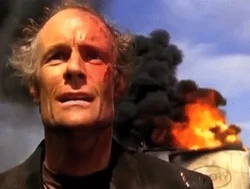 A common Stephen King device in his writing is a repetitive noise, phrase, or saying. His Trashcan Man’s “Bumpty-bump!” and “My life for you.” One of the things that the 2020 Remake minimized is the Larry Underwood song, “Baby, Can You Dig Your Man?” In TS:TOS, everyone from Trashcan Man to Glen to Randall sang it throughout the series. It’s just a nice common thread that ties it all together.
A common Stephen King device in his writing is a repetitive noise, phrase, or saying. His Trashcan Man’s “Bumpty-bump!” and “My life for you.” One of the things that the 2020 Remake minimized is the Larry Underwood song, “Baby, Can You Dig Your Man?” In TS:TOS, everyone from Trashcan Man to Glen to Randall sang it throughout the series. It’s just a nice common thread that ties it all together.
SUMMARY: Not enough key repetitive sounds, phrases, and noises, especially Larry’s song to make the series more cohesive.
CASTING/PERFORMANCES
I realize that many of the 1994 cast have aged out of playing the characters that made TS:TOS great. Not only do I realize this, but I actually looked forward to new actors making the roles their own and special in all new ways. What I didn’t expect was that across the board (for the most part) the new actors turned in lack-luster, anemic performances, blemishing the legacy of a great book and iconic mini-series. In all fairness to the new actors, some of the blame has to lay at the feet of the script, and some at the casting directors’.
 Stu Redman – James Marsden, a personal favorite from The X-Men and Hairspray, was an attractive addition to the cast of the Remake, but Gary Senise made the TS:TOS character human, three dimensional, and believable. While in general, the Remake was a fairly lame, Marsden helped it be slightly less lame.
Stu Redman – James Marsden, a personal favorite from The X-Men and Hairspray, was an attractive addition to the cast of the Remake, but Gary Senise made the TS:TOS character human, three dimensional, and believable. While in general, the Remake was a fairly lame, Marsden helped it be slightly less lame.
Frannie Goldsmith – Not a big Molly Ringwald fan, but she made the TS:TOS character so much more likable than Odessa Young in the Remake. Young wasn’t even all that attractive, and given her prominence and the need to make her appealing, a little more Cover Girl wouldn’t have hurt. Young’s rejection of Harold early on was a little too harsh and made her less likable. Maybe it was the script. But whatever the cause, Ringwald’s character helped make The Stand: The Original Series a superior product.

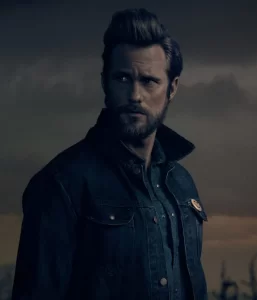 Randall Flagg – this would have been a tough character to cast. Skarsgård was better looking. Almost too much so. That hair was just TOO hip. Sheridan’s Flagg’s square jaw and leonine (out of date, yet evil looking) hair style worked to make him look even more evil. Skarsgård seemed to phone in the part. Flagg’s power was/is generated by the adoration/fear of his followers, who he manipulates via charisma, manipulation, and occasional supernatural feat. Sheridan’s ability to smile, converse, and even encourage his followers and enemies made him both three dimensional and creepy. Literally, a cool politician from hell.
Randall Flagg – this would have been a tough character to cast. Skarsgård was better looking. Almost too much so. That hair was just TOO hip. Sheridan’s Flagg’s square jaw and leonine (out of date, yet evil looking) hair style worked to make him look even more evil. Skarsgård seemed to phone in the part. Flagg’s power was/is generated by the adoration/fear of his followers, who he manipulates via charisma, manipulation, and occasional supernatural feat. Sheridan’s ability to smile, converse, and even encourage his followers and enemies made him both three dimensional and creepy. Literally, a cool politician from hell.

Mother Abigail – I’m going to focus on the performances, as I am predisposed AGAINST Whoopi Goldberg (thank you The View). In TS:TOS, the Mother Abigail character was welcoming, friendly, hymn-singing, guitar-playing, and generally appealing. Whoopi in the Remake was not likable at all. TS:TOS made Mother Abigail seem like a true woman of God who comes to realize she has sinned in pride. The Remake made Whoopi look like she was doing it for the paycheck. Apropo nothing, Ruby Dee was 72 when she played Mother Abigail in TS:TOS.
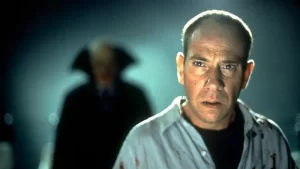 Lloyd Henreid – In The Stand : The Original Series, Miguel Ferrer portrayed a wild-eyed redneck, who was imprisoned during Captain Trips, left to starve, then saved by Randall Flagg. Along the way, his story arc morphed him into a more reserved, sophisticated lieutenant that while realizing Flagg was evil, owed him a debt he could never repay and thus stayed loyal to the demon until the end. Miguel did this perfectly. You can see the intelligence growing, the realization that Flagg was evil, the regret in his path, and even the loyalty when he doesn’t rat out the ones trying to escape. Nat Wolf played the part like a one dimensional pimp. Could have been the script. Or…not.
Lloyd Henreid – In The Stand : The Original Series, Miguel Ferrer portrayed a wild-eyed redneck, who was imprisoned during Captain Trips, left to starve, then saved by Randall Flagg. Along the way, his story arc morphed him into a more reserved, sophisticated lieutenant that while realizing Flagg was evil, owed him a debt he could never repay and thus stayed loyal to the demon until the end. Miguel did this perfectly. You can see the intelligence growing, the realization that Flagg was evil, the regret in his path, and even the loyalty when he doesn’t rat out the ones trying to escape. Nat Wolf played the part like a one dimensional pimp. Could have been the script. Or…not.
 Nick Andros & Tom Cullen – I can’t even discuss the differences between the characters/actors of Nick Andros & Tom Cullen (Rob Lowe & Bill Fagerbakkev – brilliant casting by the way!) in TS:TOS and the remake (Henrique Zaga& Brad William Henke). It would be like comparing apples to tree sap. And the rewrites of their fates in the story! Oy!
Nick Andros & Tom Cullen – I can’t even discuss the differences between the characters/actors of Nick Andros & Tom Cullen (Rob Lowe & Bill Fagerbakkev – brilliant casting by the way!) in TS:TOS and the remake (Henrique Zaga& Brad William Henke). It would be like comparing apples to tree sap. And the rewrites of their fates in the story! Oy!
Nadine Cross – In The Stand : The Original Series, Laura San Giacomo’s Nadine started off edgily ‘off’ and throughout the course of events of the series, devolves into literally out-of-her-mind, bag-of-rats crazy. Amber Heard’s Nadine was wishy-washy, vacillating between Flagg’s ‘maybe’ queen to an anemic character that Larry (nor anybody else) wouldn’t want to love.
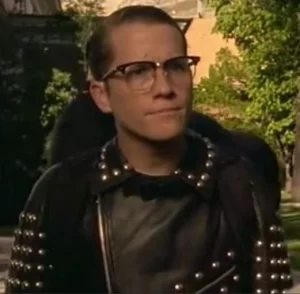

Harold Lauder – I think this was a case of less is more. In The Stand: The Original Series, Corin Nemec plays the twisted wannabe with just the right amount of…something. He came across as the Loser that everyone knows. Unrequited love, bad skin, bad hair, nerdy glasses, an aggro attitude to cover his insecurities. Perfection. We loved to hate this guy and we feel like we grew up with him. He’s the quiet guy in the clock tower that everyone said was “a quiet man who kept to himself.” In the Remake, actor Owen Teague played the character completely over-the-top. His big toothed grin, long hair, and actions were just a trope of a bad guy. He was acting like an evil villain while Nemec embodied damaged goods turned to evil.
SUMMARY: TSS:OS cast made the characters feel real, three dimensional, personal, and personable, while, overall, the Remake cast seemed like they were acting like the characters, not making them live.
I blame Stephen King
With his clout and the marketability of The Stand, you can’t tell me he did have cast and script approval. He could have stopped this inferior product from getting out as it was, and delivered a much better, much improved new mini-series. But Like Under the Dome, I think Mr. King (who is probably my all-time favorite author) laughed all the way to the bank with these later projects. He’s 76 years old and worth 500-600 million dollars. He doesn’t need to let crappy versions of his great book be remade. And yet he does.
Now this is all just my opinion for what it’s worth and if you disagree, “good on ya!” Different opinions make for great discussion. For me, I will stick to The Stand (original ) mini-series and the book.